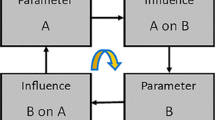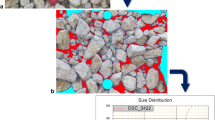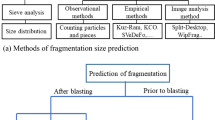Abstract
Rock mass fragmentation process plays a major role in the design of the block cave mining. To assess rock mass fragmentation, identification and determination of influencing parameters are crucial. In most case studies, the cross-impact or indirect interaction of influencing parameters has not been considered in the assessment of rock mass fragmentation. The aim of this paper is to present a hybrid approach to consider the direct and indirect effects of influencing parameters on rock mass fragmentation by use of classic rock engineering system (RES) and matrices impact cross multiplication applied to classification method (MICMAC). The most important effective parameters in the system were identified and ranked based on both RES and hybrid approach. Thereafter, the indirect fragmentation index was calculated for RENO and Diablo Regimente mines in Chile and Kemess mine in Canada. An appropriate consistency was found between the results of the hybrid approach and available fragmentation data of the respective mines. The result of the analysis showed that the interaction of the geometrical and operational parameters has increased while the interaction of the geomechanical parameters, due to being less susceptible to change of the other parameters, has decreased in the hybrid approach compared to the RES. The geomechanical parameters showed the highest impact on the system and the lowest share of interaction in the system. The geometrical and operational parameters showed a high level of interaction, in the system, which the system had low influence on them.







Similar content being viewed by others
References
Ali KM, Hasan K (2002) Rock mass characterization to indicate slope instability in Bandarban: a rock engineering systems approach. Environ Eng Geosci 8(2):105–119
Benardos AG, Kaliampakos DC (2004) Modelling TBM performance with artificial neural networks. Tunn Undergr Space Technol 19:597–605
Brazovic A, Villaescusa E (2007) Rock mass characterization and assessment of block-forming geological discontinuities during caving of primary copper ore at the El Teniente mine, Chile. Int J Rock Mech Mining Sci 44:565–583
Brown ET (2003) Block caving geomechanics. Julius Kruttschnitt Mineral Research Centre, Australia
Catalan A, Rogers S, ElmoD, Webb G (2010). A DFN based approach to defining in situ, primary and secondary Fragmentation distributions for the Cadia East panel cave project. In: 2nd Int. Symp. On block and sublevel caving, Perth, pp 425–439
Chung F, Simpson O (2018) Computing heat kernel pagerank and a local clustering algorithm. Eur J Comb 68:96–119
Dershowitz WS, Lee G, Geie J, LaPointe PR (1998) FracMan: interactive discrete feature data analysis. Geometric modeling and exploration simulation. User Documentation
Diaz R (2013) Indirect influence. Adv Stud Contemp Math 23:29–41
Dorador L, Eberhardt E, Elmo D, Aguayo A (2014) Assessment of broken ore density variations in a block cave draw column as a function of fragment size distributions and fines migration. In: 3rd international symposium on block and sublevel caving, Santiago, Chile, pp 109–118
Eadie B (2003) A framework for modeling fragmentation in block caving. Ph.D. Thesis, The University of Queensland
Elmouttie MK, Poropat GV (2012) A method to estimate in situ block size distribution. Rock Mech Rock Eng 45:401–407
Esterhuizen GS (2005) A program to predict block cave fragmentation. Technical report and user’s guide
Faramarzi F, Mansouri H, Farsangi MAE (2014) Development of rock engineering systems-based models for flyrock risk analysis and prediction of flyrock distance in surface blasting. Rock Mech Rock Eng 47(4):1291–1306
Godet M (2000) The art of scenarios and strategic planning: tools and pitfalls. Technol Forecast Soc Chang 65(1):3–22
Gomez R, Castro R, Casali A, Palma S, Hekmat A (2017) A comminution model for secondary fragmentation assessment for block caving. Rock Mech Rock Eng 50(11):3073–3084
Hadjigeorgiou J, Lessard JF, Flament F (1995) Characterizing in situ block size distribution using stereological model. Can Tunn J 1:201–211
Hudson JA (1992) Rock engineering systems: theory and practice. Ellis Horwood, Chichester
Hudson JA (2013) A review of rock engineering systems (RES) applications over the last 20 years, rock characterization, modelling, and engineering design methods. Taylor and Francis Group, London
Hudson JA, Harrison JP (2000) Engineering rock mechanics: an introduction to the principles. Elsevier, Oxford
Hurtado JP, Pereria J (2009) Fragmentation back-analysys: sector Reservas Norte. Technical Report, Division El Teniente, Coldeco
Hustrulid WA, Bullock RL (2001) Underground mining methods. Society for mining, metallurgy and exploration (SME), Englewood, pp 16–17
Jakubec J, Lakaviev L, Major K (2016) Technical report for the kemess underground project and kemess east estimate. AuRico Metals Inc, Tornoto
Jiao Y, Hudson JA (1995) The fully-coupled model for rock engineering systems. Int J Rock Mech Min Sci Geomech Abstr 32(5):491–512
Jing L (2000) Block system construction for three-dimensional discrete element models of fractured rocks. Int J Rock Mech Min Sci 37:645–659
Khalokakaie R, Zare NM (2012) The assessment of rock slope instability along the Khosh-Yeylagh main road (Iran) using a systems approach. Environ Earth Sci 67(3):665–682
Kim T (2004) Development of a fuzzy logic based utilization predictor model for hard rock tunnel boring machines. Dissertation, Colorado School of Mines
Latham JP, Lu P (1999) Development of an assessment system for the blast ability of rock masses. Int J Rock Mech Min Sci 36(1):41–55
Laubscher DH (2000) A practical manual on block caving. Julius Kruttschnitt Mineral Research Centre, University of Queensland, Queensland
Laubscher DH, Jakubec J (2000) The MRMR rock mass classification for jointed rock masses. Society of Mining Engineers, AIME, pp 475–481
Lu J (2002) polyhedral rock blocks with arbitrary joints and faults. Comput Geotech 29:49–72
Maerz NH, Germain P (1992) Block size determination around underground openings using simulations based on scanline mapping. In: Proceedings of the 2nd international conference on fractured and jointed rock masses. Lake Tahoe, CA, pp 34–41
Mazzoccola DF, Hudson JA (1996) A comprehensive method of rock mass characterization for indicating natural slope instability. Q J Eng Geol 29:37–56
Mohammad Khani M (2014) Application of rock engineering systems to block caving. Ph.D. Dissertation, School of Civil Engineering of the University of Queensland, Australia
Noroozi M, Kakaie R, Jalali SE (2015) 3D stochastic rock fracture modeling related to strike-slip faults. J Mining Environ 6(2):169–181
Pierce M (2010) A model for gravity flow of fragmented rock in block caving mines, Ph.D. Dissertation, Queensland University
Rafie R, Ataei M, Khalokakaei R, Jalali SE, Sereshki F (2015) Determination and assessment of parameters influencing rock mass caveability in block caving mines using the probabilistic rock engineering system. Int J Rock Mech Rock Eng 48(3):1207–1220
Rogers S, Elmo D, Webb G, Catalan A (2014) Volumetric fracture intensity measurement for improved rock mass characterisation and fragmentation assessment in block caving operations. Rock Mech Rock Eng 48(2):633–649
Rozos D, Pyrgiotis L, Skias S, Tasagratos P (2008) An implementation of rock engineering system for ranking the instability potential of natural slopes in Greek territory. An application in Karditsa County. Landslides 5(3):261–270
Sainsbury DP, Pierce ME (2011) A historical review of the development of numerical cave propagation simulations. In: Proceedings of the 2nd international FLAC/DEM symposium on numerical modelling, Melbourne
Shin HS, Kwon YC, Jung YS, Bae GJ, Kim YY (2009) Methodology for quantitative hazard assessment for tunnel collapses based on case histories in Korea. Int J Rock Mech Min Sci 46(10):72–87
Srikant A, Nicholas D, Rachmad L (2004) Visual estimation of fragment size distribution in the DOZ block cave. In: Proceedings of the 4th international conference and exhibition MassMin, Santiago, pp 286–290
Villaescusa E, Brown ET (1992) Maximum likelihood estimation of joint size from trace length measurements. Rock Mech Rock Eng 25:67–87
Vyazmensky A, Elmo D, Stead D, Rance J (2007) Combined finite-discrete element modeling of surface subsidence associated with block caving mining. In: Proceedings of 1st Canada-U.S. Rock Mechanics Symposium, Vancouver, pp 467–475
Wang LG, Yamashita S, Sugimoto S, Pan C (2003) A methodology for predicting the in situ size and shape distribution of rock blocks. Rock Mech Rock Eng 36(2):121–142
Zare NM, Jimenez R, Khalokakaie R, Jalali SE (2011) A probabilistic systems methodology to analyze the importance of factors affecting the stability of rock slopes. Eng Geol 118(3):82–92
Author information
Authors and Affiliations
Corresponding author
Additional information
Publisher's Note
Springer Nature remains neutral with regard to jurisdictional claims in published maps and institutional affiliations.
Rights and permissions
About this article
Cite this article
Azadmehr, A., Jalali, S.M.E. & Pourrahimian, Y. An Application of Rock Engineering System for Assessment of the Rock Mass Fragmentation: A Hybrid Approach and Case Study. Rock Mech Rock Eng 52, 4403–4419 (2019). https://doi.org/10.1007/s00603-019-01848-y
Received:
Accepted:
Published:
Issue Date:
DOI: https://doi.org/10.1007/s00603-019-01848-y




